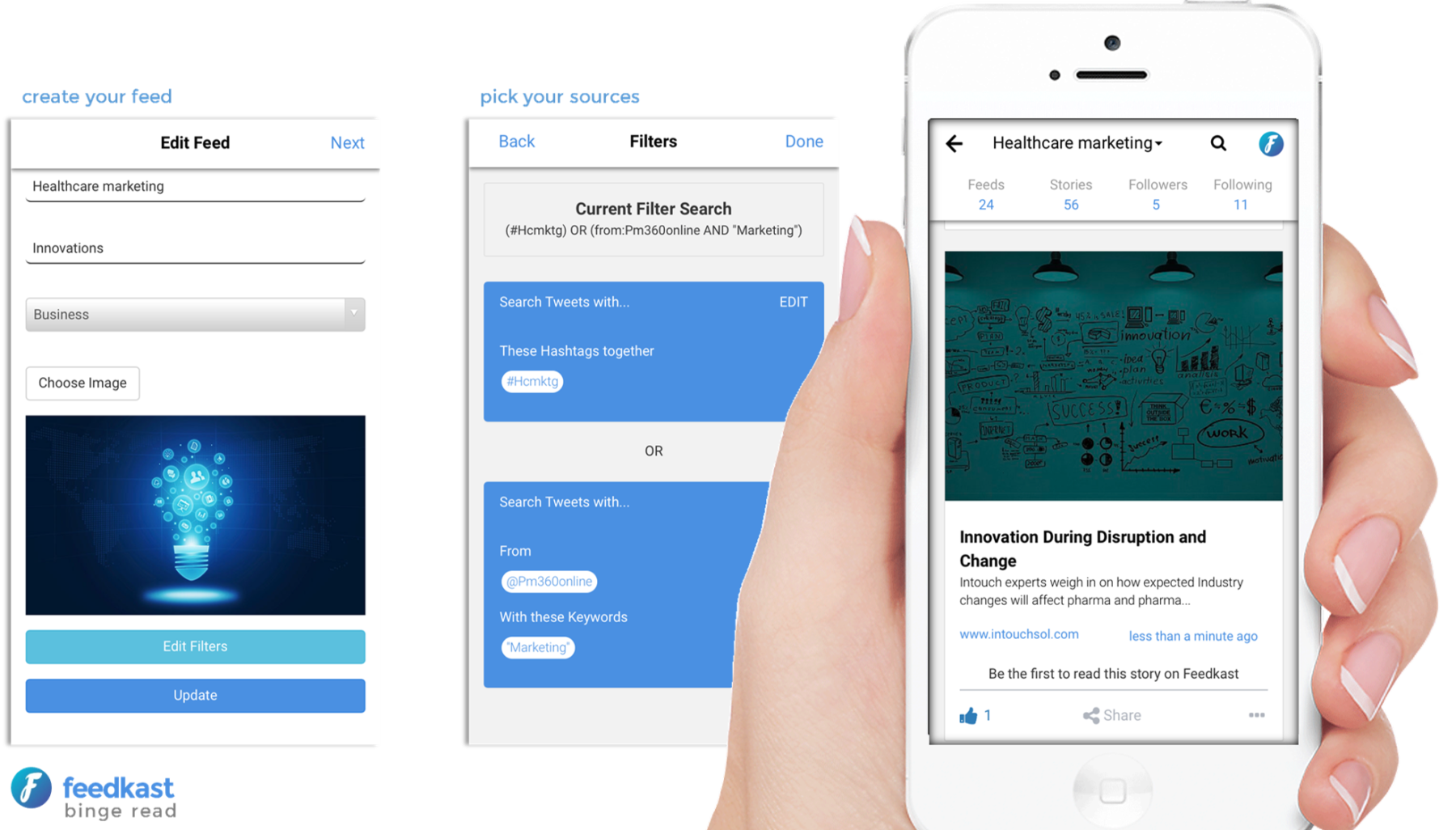Right now your Twitter feed probably consists of (un)welcome political opinions/rants, some cute cat/dog/baby videos, maybe some news about your favorite sports team or TV show, and then mixed in with all of that is the actual content you’re interested in right now. Charles Benaiah, and his company watzan, aim to change that with their latest product—feedkast. Described by Benaiah as Google Alerts meets social media, feedkast offers users an ongoing way to find on-point stories for you.
It has a somewhat similar goal to the recently announced collaboration between Symplur and Stanford Medicine X, in which they have created a public hub for research articles having to do with healthcare social media. The project, called #hcsmR, offers a searchable database of journal articles dealing with healthcare social media that readers can also rate. People can also sign up to receive updates of newly published articles via email.
While feedkast will also help to compile articles on specific subjects, it will go about it in a different way—and can be used to find content on absolutely any subject. Users will be able to create feeds on subjects relevant to them. Furthermore, the product also builds content around community, so people can create feeds and choose content based on other users.
With feedkast set to launch on March 6, PM360 spoke to Benaiah about how this new offering will allow people to find relevant content in the Internet haystack and how that can make life easier for marketers.
PM360: How did you arrive at the idea for feedkast?
Charles Benaiah: Listen, I am fan of Twitter. I love following people. In fact, I’m one of those people who find that it’s okay to follow 1,000 people and have only six people follow me because I’m more interested in finding where great content is coming from. But over the last couple of years, as my feed grew, it became impossible to actually separate the wheat from the chaff. My timeline became filled with a lot of impressions of whatever people saw that day, opinions about pizza, complaints about snow, and, of course, cat pictures. Now that is great for some people, and it is something that Twitter does well, but I needed to cut through that clutter to get to the meat of what I was looking for.
So the first thing I was interested in was: How could I bring stories that are relevant to me to the forefront? Then, the second part of that is: How do I separate my interests? For example, I’m interested in healthcare marketing as well as the Montreal Canadians, but I don’t want stories for both to appear in the same feed—I want them to be separate. And so, from a purely personal perspective, I asked our team, “How can we build a product that serves my needs?”
But as we began to really think through it and build it over the last 10 months, it turned out to meet a lot of people’s needs. We even found a Twitter chat from early December in which three KOLs in oncology basically said, “We want a product that is going to cut through the clutter. Take out the retweets and allow me to see content on the scientific research that I want. And we want it to have a simple UI and for it to be thematic so I can drill down into multiple myeloma versus other aspects of hematology.”
And as it happens, that’s exactly what we were building with feedkast.
How do users apply that filter to sort out what they want to find? Is it like Symplur, which looks at healthcare hashtags?
Symplur is wonderful in a sense that it will show you all sorts of stats on what’s happening on Twitter. They can look at a hashtag and show you how many people tweeted about it, who they were, what the connectivity was, and how many impressions it generated.
We’ve taken a slightly different approach. If you want to find content on, let’s say, multiple myeloma, then we can, of course, filter content using a hashtag for multiple myeloma. But what you could also do is set up a consistent search that is more specific. For instance, you could say, “I only want to pull content on multiple myeloma from the Journal of Clinical Oncology, ASCO, JAMA, and OncLive.” It will only pull content from those sources with information on myeloma. Or you could say, “I want to follow Dr. Mike Thompson and I want to see any story that this person is talking about on multiple myeloma.” And feedkast will continue to look through those sources constantly and put those stories directly into your feed.
Can it also offer suggestions for people to follow or sources to pull from?
It can do a couple of things. It segments your reading into feeds and it is its own social platform. So you can create your own feed on multiple myeloma and set it up exactly the way you’d like. Then you can set up a second feed on a completely separate topic. You can also follow other people or subscribe to as many feeds as you like. Over time, you can see who you’re following and begin to define a community for yourself in the same way you do on other social media platforms.
The data is inherent in the system. As this scales, it will have the capability to make recommendations. We’ll be able to see who is relevant to people, what topics are relevant to people, what accounts are relevant to people, and then begin to make increasingly smart recommendations.
People can also see what stories someone they follow has already read if they are using the same feed. So if they are scrolling through eight or 10 hematology articles, they can see that three of their friends read article number two. They will probably be more predisposed to take a look at that article if they only have a limited time. We’re really beginning to aid the discovery process of content by creating this social network and allowing people to personalize the kind of content they want coming at them.
Will this just be offered to doctors or will it to be available to anybody?
We’re going to make it available to anybody. We thought about this being a terrific product for doctors because they’ve literally explained what they want and they talk about it a lot. But agencies and clients have told us that it would be a great platform for patients as well. For instance, a recently diagnosed diabetes patient might want to learn more about healthier living or what their treatment options are, so they could create a feed on that. But as we’re beginning to go through some pretty robust testing, we’re finding that this really suits the needs for everybody.
We’ve got about 20 or 30 feeds in it right now including ones on LeBron James, Tiger Woods, the Super Bowl, the Golden Globes, barbeque sauce, and Martha’s Vineyard. So our thought is to just make it widely available. Our monetization strategy, however, is going to be around healthcare because our niche has always been in the healthcare market and serving the need of HCPs and brands, but the tool itself is much broader than healthcare.
How do people access the program? Is it a standalone app or does it integrate with Twitter?
It is a separate app, so people will not be able to open their Twitter app and use it in the same way as Twitter add-ons such as TrueTwit or Buffer. We’re actually hoping the platform will eventually bring in all sorts of content beyond just Twitter. For example, if you want to learn more about Tiger Woods’ golf swing, it might pull stories from a variety of sources on Twitter, but it could also show you YouTube videos about his swing. We also hope we can find a better way to put brands into the conversation.
In terms of brands, have you talked to any pharma clients about how this might benefit marketers?
One public company with a niche product that affects about 10,000 people about to hit the market is looking at this as a way to help find the doctors who treat this disorder, since only about 50 to 100 doctors will ultimately write scripts for this particular product. So it is like finding a needle in the haystack. In fact, if you do a search on WebMD for articles that have been published for doctors on this condition over the last year, there’s literally one article. This company is looking at feedkast as a way that they can make a concerted effort to curate content from a wide variety of sources and bring these 50 to 100 doctors a lot of value that they couldn’t find before.
Then for broader brands, it becomes more about personalization. For instance, with diabetes products their target audiences in the HCP community reach more than 100,000. And in the last four or five months, a major theme that has emerged within pharma companies is the ability to provide a real customer experience that offers true value. Intrinsic in that is the ability to allow doctors to figure out what content they want, provide them better ways to access it, and almost step aside with respect to their brand messaging. And when they want to have a dialogue with doctors, keep it focused on the content that’s relevant, scientific, and meaningful to them, more so than just a promotional message. Products like feedkast can be a great way to do that for brands.
I imagine that you will also be able to collect a lot of data that would be valuable to pharma companies, as you will have all of this information about who is looking at certain disease categories as well as what sources people most like to read. Will you be offering that data back to companies to use for their own purposes?
One of the things that I noticed as I began to significantly test this program in late November was the incredible amount of diversity in a particular feed that I had created for sports. It wasn’t just going back to ESPN and Bleacher Report every day. I was seeing stories from probably 50 or 60 different sources and reading an incredibly more diverse amount of content. As a result, I wanted to build that directly into the platform. And so that type of stuff is very transparent to every user who is in the system. You will begin to see the top five sources in that feed, the top five sources read by the people in the field, or the top sources of content your friends are reading.
Beyond that, our model for the pharma industry is: If you want to sponsor a particular feed or advertise in a particular feed for a given term, we could give you data back, such as the top sources of content that people following this feed are reading, or what other topics people who are reading this feed are also looking at. But we’re not going to give it back to pharma on a granular basis as that would be a violation of people’s privacy. However, the aggregate data could be extremely interesting and helpful in allowing pharma to better understand where they should be putting their content.
How else will companies be able to advertise other than sponsoring a feed?
With our other product, mapt, we tried to encourage people to branch out beyond the idea of putting a promotional banner ad in front of a particular person. Obviously, we’ve seen the rise of ad blockers. Additionally, doctors are coming out and saying they don’t want to see pharma ads in streams anymore.
So while we are telling clients that they can still put a promotional ad in front of people, we are suggesting that they are much better off putting things that we would consider to be branded content in front of them. For instance, a MOA video that shows up in their feed is going to have a much higher amount of engagement than a banner ad—plus it is far less likely to be blocked.
I personally think that we’re moving toward that paradigm, not just in medical, but in general throughout the advertising world. More native content and less on-point promotional stuff. You can put content that’s valuable to the reader in front of them and still get your brand’s point across without being overly promotional about it.









